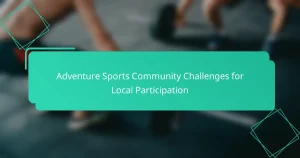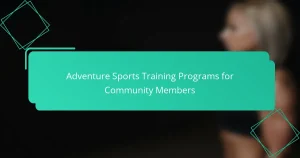Adventure sports create opportunities for community building and networking among enthusiasts. These activities foster social interaction, collaboration, and mutual support through events and competitions. Local clubs and online platforms enhance participation and resource sharing, while technology facilitates connections and communication. Addressing challenges like funding and safety is essential for developing sustainable adventure sports communities.
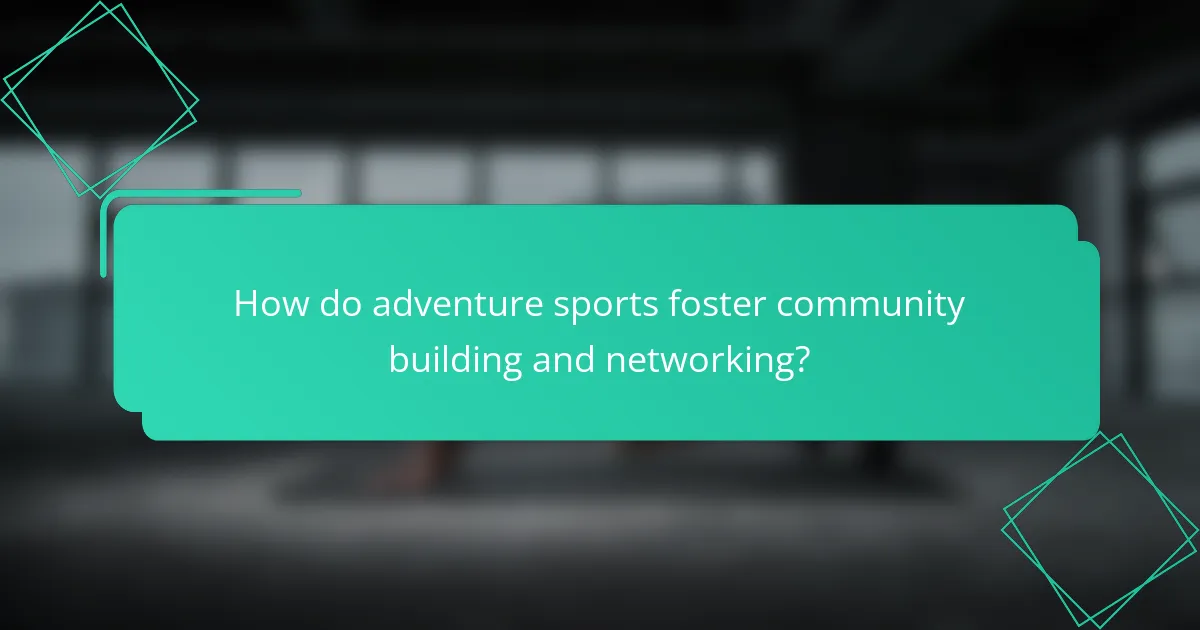
How do adventure sports foster community building and networking?
Adventure sports foster community building and networking by creating shared experiences among participants. These activities encourage social interaction, collaboration, and mutual support.
Adventure sports often host events and competitions that bring together diverse groups, fostering connections. Participants frequently form lasting friendships and professional networks through teamwork and shared challenges.
The unique attributes of adventure sports, such as risk-taking and exploration, enhance bonding experiences. Engaging in these activities promotes trust and camaraderie, crucial for community development.
Additionally, local adventure sports clubs and organizations often facilitate networking opportunities through workshops and events, strengthening community ties.
What are the primary benefits of community engagement in adventure sports?
Community engagement in adventure sports fosters social connections, enhances teamwork, and promotes physical health. It encourages local participation, leading to stronger community ties and shared experiences. Additionally, it can boost local economies through events and tourism. Engaging in adventure sports often develops leadership skills and environmental awareness, creating a positive impact on both individuals and communities.
Which adventure sports are most effective for networking opportunities?
Adventure sports such as rock climbing, mountain biking, and surfing provide excellent networking opportunities. These activities foster community engagement and collaboration among participants.
Rock climbing events often involve group challenges, promoting teamwork and connections. Mountain biking trails frequently host community rides, allowing riders to meet and share experiences. Surfing competitions and meetups create a vibrant social scene, encouraging friendships and partnerships.
Engaging in these sports can lead to valuable professional relationships, as participants often share similar interests and goals. Networking in adventure sports can enhance personal and professional growth through shared experiences and camaraderie.
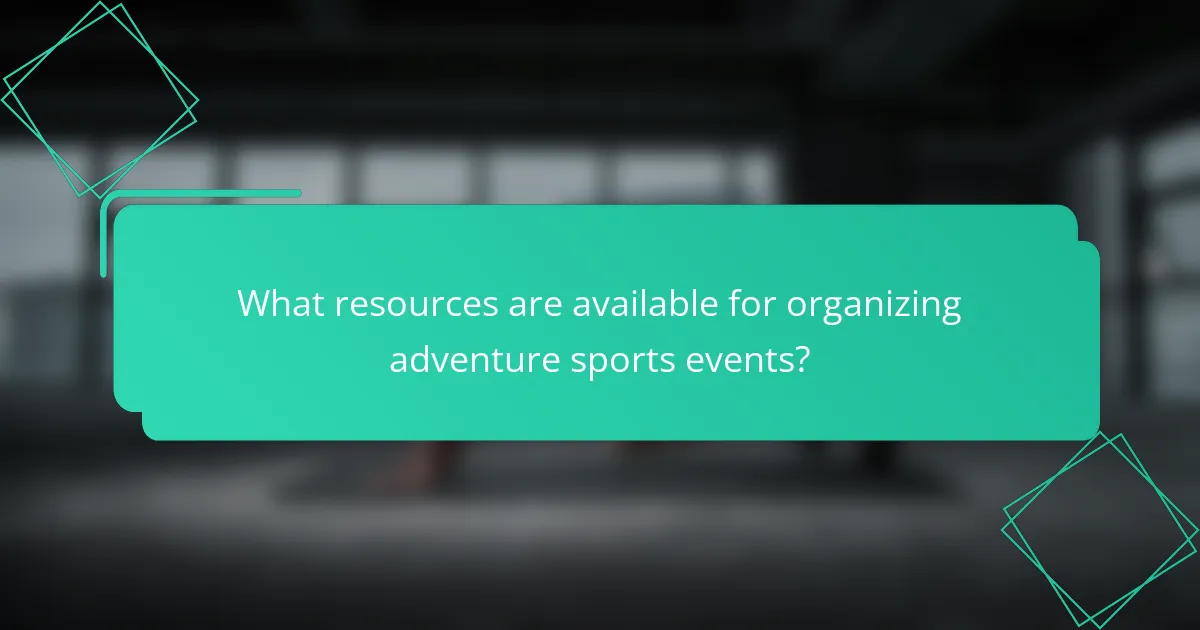
What resources are available for organizing adventure sports events?
Numerous resources exist for organizing adventure sports events, enhancing community building and networking. Local sports clubs provide venues and participant access. Online platforms facilitate event promotion and registration. Sponsorship opportunities from brands boost funding. Networking events connect organizers with enthusiasts. Training programs improve safety and skills. Community forums foster collaboration and idea sharing.
How can local organizations facilitate adventure sports gatherings?
Local organizations can facilitate adventure sports gatherings by providing venues, resources, and networking opportunities. They can host events that connect enthusiasts, promote safety training, and offer equipment rentals. Collaborations with local businesses enhance sponsorship and support. Additionally, organizations can create online platforms for community engagement and information sharing. These actions foster a vibrant adventure sports culture and encourage participation.
What platforms are popular for promoting adventure sports events?
Social media platforms, event management sites, and adventure sports communities are popular for promoting adventure sports events. Key platforms include Facebook, Instagram, Meetup, and Eventbrite. These platforms facilitate community engagement, event visibility, and networking opportunities. Each platform offers unique features, such as targeted advertising on Facebook and visual storytelling on Instagram, enhancing event promotion effectiveness.
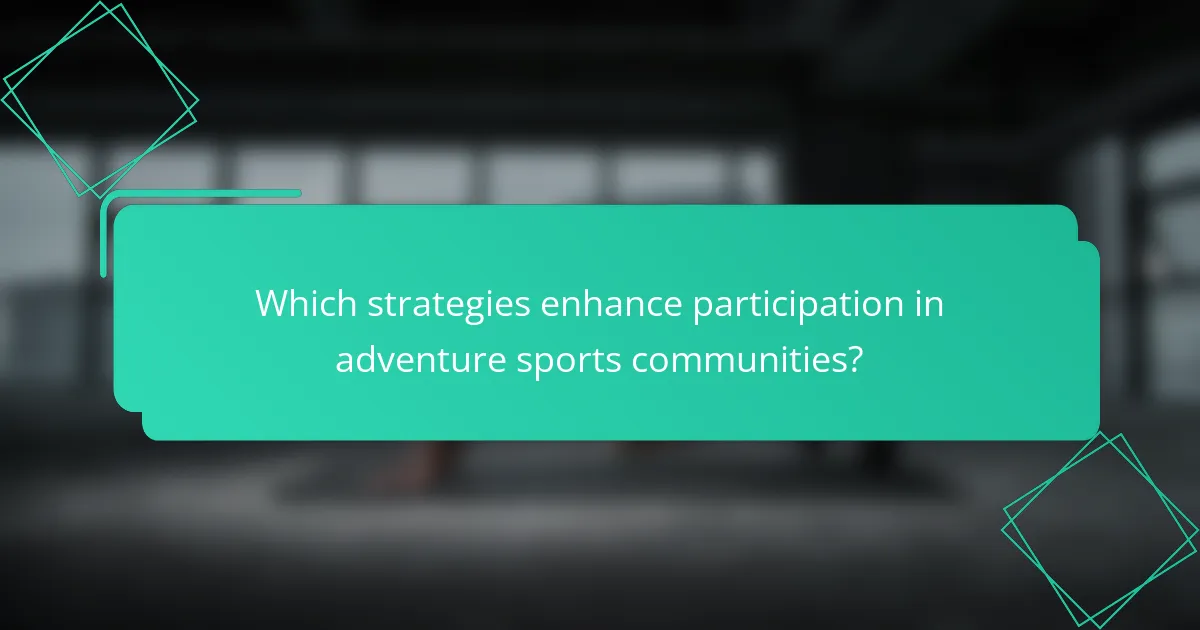
Which strategies enhance participation in adventure sports communities?
Engaging strategies to enhance participation in adventure sports communities include organizing events, fostering inclusive environments, and utilizing social media. Events like local meetups or competitions create opportunities for interaction. Inclusive environments encourage diverse participation, making everyone feel welcome. Social media platforms facilitate communication, sharing experiences, and promoting upcoming activities, thus strengthening community ties.
How do social media platforms influence community growth?
Social media platforms significantly enhance community growth by facilitating connections among adventure sports enthusiasts. They provide spaces for sharing experiences, organizing events, and exchanging resources.
Platforms like Facebook and Instagram allow users to create groups and pages focused on specific sports, fostering engagement and collaboration. These virtual communities support networking, where individuals can find partners for activities or seek advice on gear and techniques.
Moreover, social media enables the dissemination of information about local events, competitions, and workshops, which can attract new members to the community. Engaging content, such as videos and photos, showcases the excitement of adventure sports, drawing interest from a broader audience.
Finally, user-generated content encourages inclusivity, allowing all skill levels to participate and share their journeys. This dynamic interaction not only strengthens existing communities but also cultivates new ones, driving overall growth in the adventure sports sector.
What role do sponsorships play in community engagement?
Sponsorships significantly enhance community engagement by providing resources and visibility for adventure sports. They foster local connections and promote inclusivity, enabling diverse participation. For example, brands sponsoring events often organize workshops, which strengthen community ties and encourage networking. This collaborative environment can lead to increased participation in adventure sports, benefiting local economies and promoting healthy lifestyles.
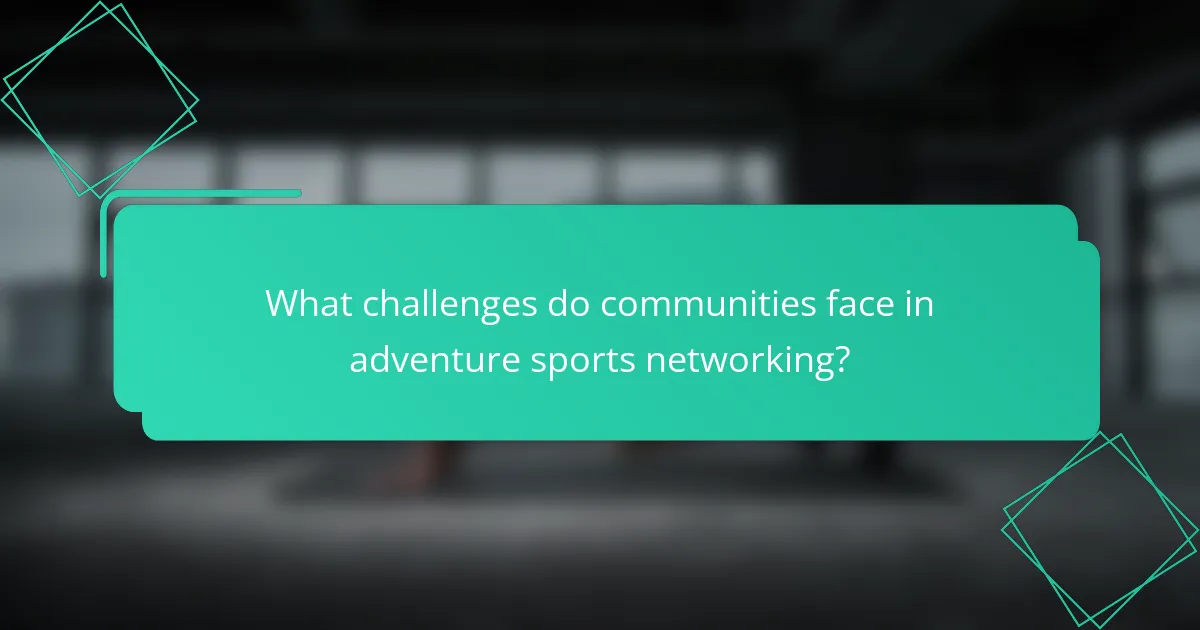
What challenges do communities face in adventure sports networking?
Communities face several challenges in adventure sports networking, including limited access to resources, lack of awareness, and insufficient collaboration among members. These obstacles hinder the growth and participation in adventure sports activities.
Limited funding often restricts the development of facilities and events. Additionally, communities may struggle with inadequate marketing strategies, resulting in low visibility for their programs. Networking opportunities can be scarce, making it difficult for individuals to connect and share experiences.
Moreover, differing levels of experience among participants can create barriers to entry, deterring newcomers. Finally, safety concerns may limit participation, as communities must ensure that activities are conducted in a secure environment. Addressing these challenges is essential for fostering a vibrant adventure sports community.
How can communities overcome barriers to participation?
Communities can overcome barriers to participation by fostering inclusive environments and providing accessible resources. Engaging local leaders enhances trust and encourages involvement in adventure sports. Collaborative events that highlight community benefits can attract diverse participants, promoting networking and shared experiences. Regular feedback loops ensure continuous improvement and responsiveness to community needs.
What are common misconceptions about adventure sports communities?
Common misconceptions about adventure sports communities include the belief that they are exclusive, dangerous, and only for extreme athletes. Many assume that these communities lack support for beginners, which is not true. In reality, adventure sports communities often prioritize inclusivity and safety, providing resources and mentorship for all skill levels. Additionally, the perception that these communities are only focused on competition overlooks their emphasis on camaraderie and shared experiences.

How can technology improve networking in adventure sports?
Technology enhances networking in adventure sports by facilitating connections and sharing resources. Online platforms and apps enable athletes to find partners, share experiences, and access training resources. Social media fosters community engagement, allowing users to exchange tips and organize events. Virtual reality offers immersive experiences that connect enthusiasts globally. Data analytics helps identify trends and preferences, tailoring experiences to user needs. Overall, technology creates a more cohesive and informed adventure sports community.
Which apps are most effective for connecting adventure sports enthusiasts?
Popular apps for connecting adventure sports enthusiasts include Meetup, Strava, and Adventurely. These platforms foster community building through shared interests and events.
Meetup allows users to create and join groups focused on specific adventure sports, facilitating local meetups. Strava, primarily a fitness tracking app, encourages competition and community through challenges and leaderboards. Adventurely connects users with similar adventure interests for planning trips and activities.
These apps enhance networking opportunities, making it easier for enthusiasts to share experiences and form lasting connections.
What innovative tools are emerging in the adventure sports sector?
Innovative tools in the adventure sports sector include mobile apps, wearable technology, virtual reality experiences, and online platforms for community engagement. These tools enhance safety, improve training, and foster connections among enthusiasts. For example, mobile apps provide real-time weather updates and route tracking, while wearable devices monitor health metrics during activities. Virtual reality offers immersive training environments, allowing users to practice skills in a risk-free setting. Online platforms enable networking, sharing experiences, and organizing events, strengthening community ties.

What are the unique attributes of successful adventure sports networks?
Successful adventure sports networks exhibit unique attributes that foster community engagement and collaboration. These networks prioritize inclusivity, creating environments where diverse participants feel welcomed. They leverage technology for seamless communication and resource sharing, enhancing member connectivity. Furthermore, they often organize events that promote skill development and safety awareness, reinforcing community bonds. Lastly, a strong focus on sustainability ensures that these networks contribute positively to the environment, appealing to eco-conscious members.
How do cultural differences shape adventure sports communities?
Cultural differences significantly influence adventure sports communities by shaping values, practices, and social interactions. These communities reflect diverse backgrounds, impacting participation and collaboration. For instance, in some cultures, adventure sports promote teamwork, while others emphasize individual achievement. Social norms dictate risk tolerance, influencing how activities are approached and shared. Additionally, local traditions can inspire unique sports adaptations, enriching the overall experience and fostering inclusivity. Understanding these cultural nuances enhances community building and networking, creating a more vibrant adventure sports landscape.
What are notable examples of thriving adventure sports networks?
Notable examples of thriving adventure sports networks include organizations that foster community engagement and provide resources for enthusiasts. Examples are the Outdoor Industry Association, which connects businesses and advocates for outdoor recreation, and the Adventure Travel Trade Association, promoting sustainable adventure tourism. These networks support collaboration, knowledge sharing, and event organization, enhancing the adventure sports community’s growth and connectivity.
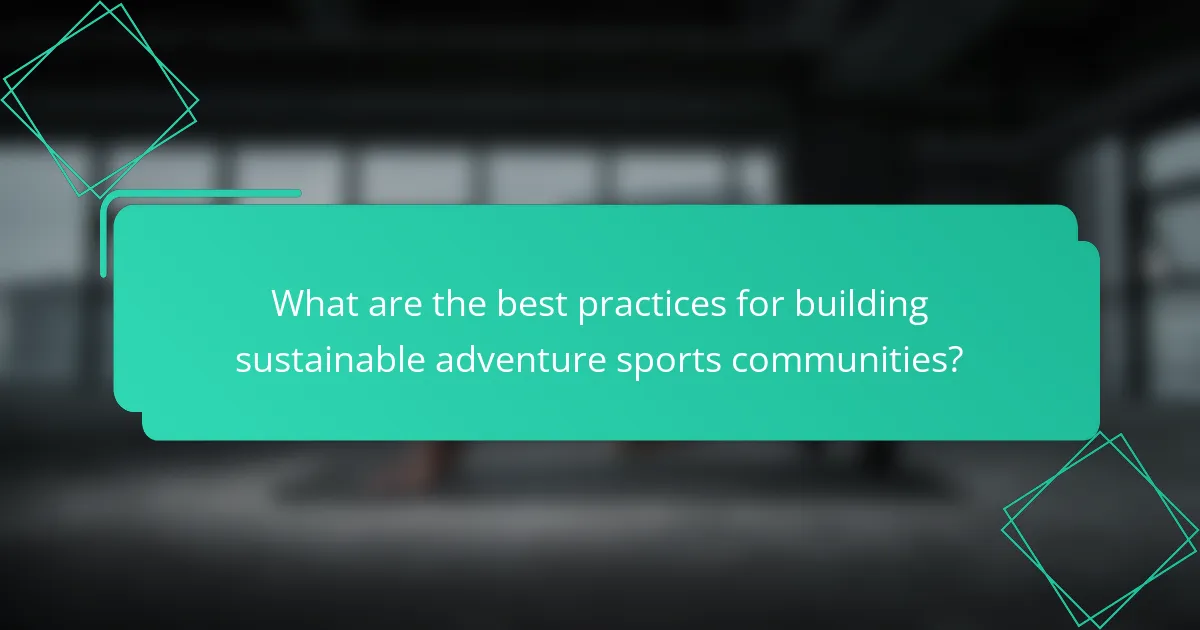
What are the best practices for building sustainable adventure sports communities?
Building sustainable adventure sports communities requires fostering connections, sharing resources, and promoting inclusivity. Focus on organizing regular events that encourage participation and collaboration among members. Establish online platforms for networking and sharing experiences, enhancing communication and engagement. Prioritize education on sustainability practices within the sports to ensure long-term viability. Form partnerships with local organizations to amplify reach and resources, creating a supportive ecosystem.
What tips do experts recommend for fostering inclusivity in adventure sports?
Experts recommend creating inclusive environments in adventure sports by promoting diverse participation, ensuring accessibility, and fostering community support. Building partnerships with local organizations can enhance outreach efforts. Offering mentorship programs encourages skill development among underrepresented groups. Regular feedback from participants helps refine inclusivity strategies, ensuring that everyone feels welcome and valued.
How can community leaders effectively engage diverse populations?
Community leaders can effectively engage diverse populations by creating inclusive adventure sports programs. These programs foster collaboration and networking among various community groups, enhancing social cohesion.
Utilizing local resources, leaders can offer tailored adventure sports activities that resonate with different cultural backgrounds. For instance, organizing events that highlight unique traditions or preferences can attract wider participation.
Additionally, establishing partnerships with local organizations can amplify outreach efforts. Collaborating with schools, cultural centers, and nonprofits can help reach underrepresented demographics, ensuring diverse voices are included.
Lastly, collecting feedback from participants can guide future initiatives. Understanding community needs and preferences allows leaders to adapt programs, making them more relevant and engaging for all.
What common mistakes should be avoided when organizing adventure sports events?
Avoiding common mistakes in organizing adventure sports events ensures successful community engagement. Key mistakes include inadequate planning, neglecting safety protocols, poor communication, and underestimating resource needs.
1. Inadequate planning can lead to logistical issues, affecting participant experience.
2. Neglecting safety protocols risks injuries and liability, damaging community trust.
3. Poor communication creates confusion among participants and volunteers, undermining event success.
4. Underestimating resource needs can result in shortages, impacting event quality.
Addressing these areas enhances organization and fosters a positive environment for community building.
